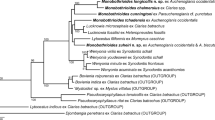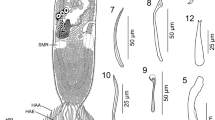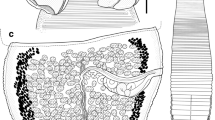Abstract
As part of a survey of the metazoan parasites of elasmobranchs of the Gulf of California, Mexico, the spiral intestines of 10 pelagic thresher sharks Alopias pelagicus and one bigeye thresher shark A. superciliosus were examined for tapeworms. Eight of the A. pelagicus specimens examined were found to host Litobothrium amplifica and L. daileyi. Both tapeworm species are redescribed based on examination of this new material with light and scanning electron microscopy, and the ranges of most of the measurements for these species are expanded; scanning electron micrographs and detailed illustrations and measurements of their segment anatomy are presented for the first time. An argument is made that the identification of the original host specimens of these species was in error and that A. pelagicus is likely to be the correct original host. In addition, L. nickoli n. sp., a third species in the genus hosted by A. pelagicus, was found in three of the 10 individual hosts examined. This species differs from all six known Litobothrium species in the form of the pseudosegments of the scolex, the anterior two being essentially non-cruciform, while the latter three are distinctly cruciform. All other species possess either no non-cruciform or at most one non-cruciform segment anteriorly. The single specimen of A. superciliosus examined was found to host the new species, L. janovyi. This species differs from L. coniformis, L. gracile and L. amsichensis in its possession of four rather than three, three and five cruciform pseudosegments, respectively. It lacks the modificiations of the fourth pseudosegment seen in L. amplifica and lacks the anterior non-cruciform fifth pseudosegment found in L. daileyi. It most closely resembles L. alopias but differs among other features in its greater total length, greater number of segments and longer mature segments. SEM of the four species collected from the Gulf of California as well as material of L. amsichensis from the goblin shark Mitsukurina owstoni that hosted the type-specimens of this species show that all surfaces of the body of all five species bear a dense covering of long filiform microtriches. L. amplifica bears a single row of large spine-like structures throughout most of the posterior margins of the first and second cruciform pseudosegment only. L. daileyi possesses one to two rows of overlapping spine-like structures on the posterior margins of the first four pseudosegments with the exception of the medial projections. The fifth pseudosegment lacks these structures. L. janovyi n. sp. bears spine-like structures on the lateral margins of only the third and fourth pseudosegments. L. nickoli n. sp. bears spine-like structures throughout the posterior margins of the first and second pseudosegments, and throughout the posterior margins of the third and fourth pseudosegments with the exception of the medial projections; the fifth pseudosegment lacks these structures. L. amsichensis bears no structures that could be considered to be spine-like on any of its pseuosegments, but possesses a border of densely arranged larger microtriches on the posterior margin of all five pseudosegments. A key to the species is included.
Similar content being viewed by others
References
Al Kawari, K.S.R., Saoud, M.F.A. & Wanas, M.Q.A. (1994) Helminth parasites of fishes from the Arabian Gulf. 7. On Eniochobothrium qatarense sp. nov. (Cestoda: Lecanicephalidea) and the affinities of Eniochobothrium Shipley and Hornell, 1906, Litobothrium Dailey, 1969 and Renyxa Kurochkin and Slankis, 1973. Japanese Journal of Parasitology, 43, 97-104.
Caira, J.N. & Runkle, L.S. (1993) Two new tapeworms from the goblin shark Mitsukurina owstoni off Australia. Systematic Parasitology, 26, 81-90.
Caira, J.N., Jensen, K. & Healy, C.J. (1999) On the phylogenetic relationships among tetraphyllidean, lecanicephalidean and diphyllidean tapeworm genera. Systematic Parasitology, 42, 77-151.
Caira, J.N., Jensen, K. & Healy, C.J. (2001) Interrelationships among tetraphyllidean and lecanicephalidean cestodes. In: Littlewood, D.T.J. & Bray, R.A. (Eds) Interrelationships of the Platyhelminthes. Taylor & Francis, London, pp. 135-148.
Compagno, L. (1984) FAO species catalogue. Vl. 4, Parts 1 and 2: Sharks of the world. An annotated and illustrated catalogue of shark species known to date. FAO Fisheries Synopsis, 125, 655 pp.
Dailey, M. (1969) Litobothrium alopias and L. coniformis, two new cestodes representing a new order from elasmobranch fishes. Proceedings of the Helminthological Society of Washington, 36, 218-224.
Dailey, M. (1971) Litobothrium gracile sp. n. (Eucestoda: Litobothridea) from the sand shark (Odontaspis ferox). Journal of Parasitology, 57, 94-96.
Euzet, L. (1994) Order Tetraphyllidea Carus, 1863. In: Khalil, L.F., Jones, A. & Bray, R.A. (Eds) Keys to the cestode parasites of vertebrates. Wallingford: CAB International, pp. 149-194.
Khalil, L.F., Jones, A. & Bray, R.A. (1994) Keys to the cestode parasites of vertebrates, Wallingford: CAB International, 751 pp.
Kurochkin, Y.B. & Slankis, A.Y. (1973) New representatives and the composition of the order Litobothridea Dailey, 1969 (Cestoidea). Parazitologiya, 7, 502-508. (In Russian).
Olson, P.D. & Caira, J.N. (1999) Evolution of the major lineages of tapeworms (Platyhelminthes: Cestoidea) inferred from 18S ribosomal DNA and elongation factor-1α. Journal of Parasitology, 85, 1,134-1,159.
Olson, P.D., Ruhnke, T.R., Sanney, J. & Hudson, T. (1999) Evidence for host-specific clades of tetraphyllidean tapeworms (Platyhelminthes: Eucestoda) revealed by analysis of 18S ssrDNA. International Journal for Parasitology, 29, 1,465-1,476.
Schmidt, G.D. (1986) Handbook of tapeworm identification. Boca Raton: CRC Press, 675 pp.
Wardle, R. A., McLeod, J.A. & Radinovsky, S. (1974) Advances in the zoology of tapeworms, 1950–1970. Minneapolis: University of Minnesota Press, 274 pp.
Author information
Authors and Affiliations
Rights and permissions
About this article
Cite this article
Olson, P., Caira, J. Two new species of Litobothrium Dailey, 1969 (Cestoda: Litobothriidea) from thresher sharks in the Gulf of California, Mexico, with redescriptions of two species in the genus. Syst Parasitol 48, 159–177 (2001). https://doi.org/10.1023/A:1006422419580
Issue Date:
DOI: https://doi.org/10.1023/A:1006422419580




